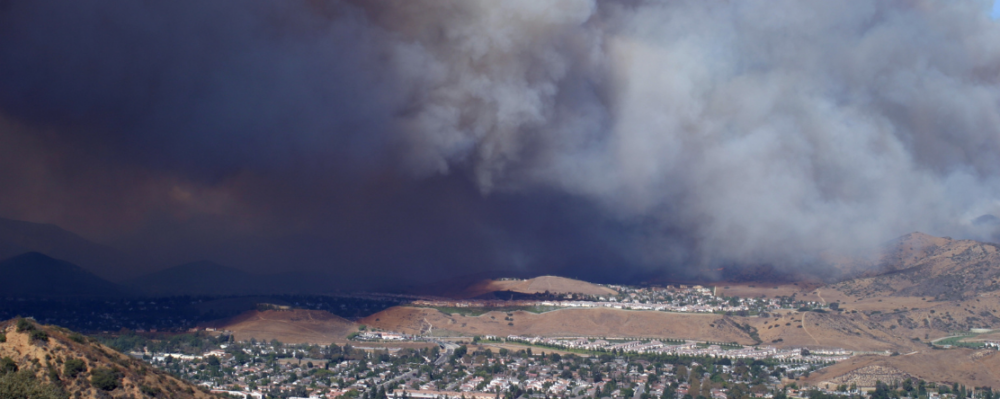
Press Release
Imperial County Community Members Launch Air Monitoring Website
-
Focus Areas
Chronic Disease Prevention, Environmental Health -
Issues
Asthma, Wildfires & Extreme Heat -
Programs
Tracking California

With Asthma ER Visits Among Highest in State, Accurate Information is “Life or Death” Issue
Brawley, CA (September 30, 2016) – In Imperial County, where particulate pollution often exceeds state standards for more than six months at a time and children have among the highest rates of asthma-related emergency room visits and hospitalizations in the state, the availability of local air quality information can be a life or death issue. On September 30th, community members and research partners in California’s Imperial County launched IVAN Air Monitoring, a community air monitoring website that puts real-time air quality information in residents’ hands.
View the Desert Sun story and video on Imperial County’s efforts.
IVAN Air Monitoring (available at www.ivan-imperial.org) was developed as part of an innovative 4-year, $2M air monitoring project funded by the National Institutes of Health and undertaken through a collaboration between local organization Comite Civico del Valle, the Public Health Institute’s California Environmental Health Tracking Program, and researchers at the University of Washington, along with other partners. Bringing together scientists, community advocates, and local residents, this project aims to collect air quality data for research while providing information that is immediately and directly useful to residents by establishing a community air monitoring network.
The project enhanced an existing community environmental monitoring website called IVAN (Identifying Violations Affecting Neighborhoods) to display current particulate pollution levels at each monitor within the community network. The website also provides recommendations for reducing exposures for each air quality level, summary statistics for air quality at each monitor, and the option to sign up for email alerts on bad air quality days.
IVAN Air Monitoring will be publicly launched during a celebratory event at Heber Elementary School, home to one of the community air monitors. Heber Elementary School’s Principal Patty Marcial has been concerned about how air pollution sources surrounding the school may be impacting students and says having a local monitor is an important step to protecting their health. “The air monitors help us to be alerted that students with asthma or breathing conditions may be affected. Knowing that the air quality is in a poor state helps us decide when to keep students indoors.”
Meadows Union Elementary School in El Centro also hosts an air monitor. Astrid Calderas, whose children Asher and Bennet Medina attend 5th grade and kindergarten at Meadows and both suffer from asthma, says this information is valuable. “In the past years, asthma has been the reason for my child’s chronic absenteeism. For me, IVAN Air Monitoring would be a reliable source to ensure my children’s safety while in school. I am very grateful that Meadows school participates in these initiatives. It indicates that they care and are interested in the welfare of their students.”
Galatea King, health surveillance director of the California Environmental Health Tracking Program, says that Astrid Calderas’s experience unfortunately isn’t unique. Referencing her program’s 2015 report on the cost of children’s environmental health, King states, “We know that asthma is one of most common chronic diseases affecting children in our state. It impacts families physically, emotionally, and financially, costing almost $700 million every year in California(1). Asthma also results in about 1.9 million missed school days among children in California(2). We hope that the community air monitoring network and the website become an additional resource that families in Imperial County will actively use to protect their health.”
One way in which IVAN Air Monitoring can help reduce the impacts of asthma is through the school flag program. Schools participating in this program display colored flags to increase awareness of current air quality conditions by children, parents, school personnel, and the community. The schools also adjust their students’ outdoor activities to reduce risk of air pollution exposure and asthma attacks when pollution levels are high.
In addition to Heber Elementary and Meadows Elementary, 12 other public schools in the county so far have agreed to host air monitors. The first community air monitor was launched last May at Brawley Union High School, and since then, the project team has installed 33 of 40 monitors, aiming to complete the network by the end of the year. The number of monitors sited at schools reflects the project’s unique effort to incorporate both scientific and community priorities into deciding where to put the monitors.
“The network wasn’t created by just setting up monitors in the homes of whoever volunteered, nor did we site monitors based solely on technical requirements at the expense of community needs,” states Edmund Seto of UW, who oversees the technical aspects of the project. Instead, the project team undertook a deliberate process to engage community residents in identifying and prioritizing where to place the first 20 monitors. “Based on those locations, we are filling in the gaps with remaining monitors, so that the data produced by the network are still useful for conducting scientific analyses to characterize air pollution trends and hotspots throughout the county.”
For Luis Olmedo, Executive Director of Comite Civico del Valle, the scientific rigor was an essential aspect to the project. “As members of this community, we have a personal interest in the quality of the data produced,” says Olmedo. Not only does the network generate data that are immediately useful to residents, the careful planning and collaboration with researchers means that the community network’s data are more likely to be both useful and useable by government agencies tasked with protecting health and the environment in the region.
For example, the Obama administration recently announced federal funding to mitigate the deterioration of the Salton Sea, while Governor Brown has set aside $80.5 million in his 2016-2017 budget for Salton Sea restoration and dust suppression. The community air monitoring network, which has monitors located around the Salton Sea to better understand air quality coming from the lake, may prove to be an important resource for guiding and evaluating these efforts.
“There are environmental public health issues, like the Salton Sea, that we’ve been aware of locally for a long time. Having state and federal resources devoted to addressing them are critical, but we also want to know that these investments actually make a positive difference for our community and our environment,” says Olmedo. “Our network is ready to help.”
—-
1. California Environmental Health Tracking Program, Public Health Institute. Costs of Environmental Health Conditions in California Children. June 2015. Available online here.
2. http://www.rampasthma.org/about-ramp/programs/schools
###
For more information contact: Ann Whidden, Public Health Institute, 415-152-5157.
About Comité Cívico del Valle
Comite Civico Del Valle, Inc (CCV) was founded in 1987 in Imperial County, California with the endeavor of improving the lives of low-income families through a broad range of approaches including civic classes and community participation in research projects.
About the California Environmental Health Tracking Program
The California Environmental Health Tracking Program (CEHTP) is a program of the Public Health Institute, in partnership with the California Department of Public Health. The mission of CEHTP is to provide data and information on diseases and environmental threats to inform environmental and public health programs, research, and policies.
About the Public Health Institute
The Public Health Institute, an independent nonprofit organization, is dedicated to promoting health, well-being and quality of life for people throughout California, across the nation and around the world.
About the University of Washington
The University of Washington School of Public Health is dedicated to education to prepare outstanding, innovative, and diverse public health leaders and scientists; research to advance public health science and policies; and service to promote the health and well-being of communities locally, nationally, and globally.
More Updates
Work With Us
You change the world. We do the rest. Explore fiscal sponsorship at PHI.
Support Us
Together, we can accelerate our response to public health’s most critical issues.
Find Employment
Begin your career at the Public Health Institute.



